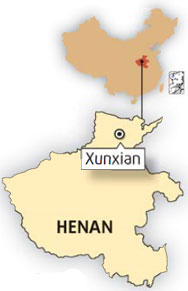
For 1,500 years, the locals have made clay figurines known as nigugu - ni means clay, gugu mimics the sound when you blow the figurines like whistles.
Local annals say that at the end of the Sui Dynasty (AD 581-618), farmers joined nationwide rebellions. Li Mi, who would found the Tang Dynasty (AD 618-907), led his troops in battle against the Sui army at Xunxian.
Li left general Yang Qi to gather the wounded soldiers and cultivate fields. To commemorate the soldiers who died in the battle, their comrades made figurines of soldiers and horses with the yellow clay abundant here.
Today, the best nigugu figurines can be found at Yangqitun village, where the general once stayed. Besides figures of ancient generals and soldiers, there are also birds and animals. On the black and brown backgrounds, red, green, blue, yellow and other bright colors are mixed with egg yolk to make them shinier.
About 550 km to the south of Beijing, Xunxian is conveniently linked with Zhengzhou and other cities. The county of only 1,000 sq km has become one of the country's most important grain bases, producing 500,000 tons every year.
The farmers from all around exude a deep pride in their local history. Xunxian was part of early Chinese civilization and traces of the agricultural Yangshao (6,000 years ago) and Longshan (4,000 years ago) cultures were discovered there.
My name, Jun, which means "to dredge a river", is pronounced as "Xun" when referring to Xunxian. As its name suggests, the county's history is closely linked with the Yellow River, which used to bring terrible floods to the Central Plains. Da Yu, a legendary tribal leader, is said to have diverted the floods at Dapi Hill.
In the 4th century, the ruler of the Later Zhao Dynasty (AD 319-351) followed the suggestion of an Indian monk and chiseled the eastern cliff of Dapi Hill into a Buddha statue to command the river.
At 23 m, the sitting statue is believed to be the oldest and biggest of its kind in northern China. A century later, people built a wooden mansion over the statue to keep it from the rain and wind. Much of the Spring Festival celebrations have evolved around the statue.
It wasn't until the 12th century that the Yellow River ceased to be the primary source of troubles for Xunxian. A breaching of the dike allowed the river to roar south for dozens of kilometers out of the county's boundary.
Zi Gong, a disciple of Confucius (551-479 BC), was a native of Xunxian. In Records of the Grand Historian, Sima Qian (145-86 BC) praised Zi Gong as the best example of utilizing Confucius' teachings. Not only was Zi Gong the prime minister of two dukedoms, he was also a very successful merchant, the richest of all of Confucius' disciples.
In The Analects of Confucius, Zi Gong and his master discussed sending presents. Some researchers say that Zi Gong liked mutton, while Confucius was also fond of receiving gifts, be it a piece of jade or meat. After your journey to my hometown, don't forget to get a steamed bun or a nigugu for your friends.
(China Daily December 5, 2008)